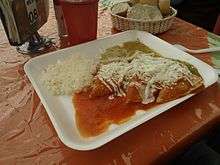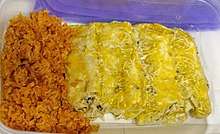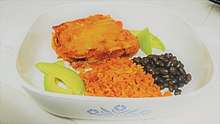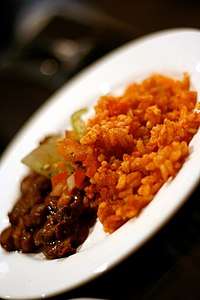Enchilada
An enchilada (/ˌɛntʃɪˈlɑːdə/, Spanish: [entʃiˈlaða]) is a corn tortilla rolled around a filling and covered with a savory sauce. Enchiladas can be filled with various ingredients, including meats, cheese, beans, potatoes, vegetables or combinations. Sauces can also be used to cover enchiladas, including chili-based sauces, such as salsa roja, various moles, or cheese-based sauces, such as chile con queso. Originating in Mexico, enchiladas are a common dish in Mexican cuisine.
 Enchiladas with mole, served with refried beans and Spanish rice | |
| Place of origin | Mexico |
|---|---|
| Main ingredients | Tortillas, chili pepper sauce, meat |

Etymology
The Real Academia Española defines the word enchilada, as used in Mexico, as a rolled maize tortilla stuffed with meat and covered with a tomato and chili sauce.[1][2] Enchilada is the past participle of Spanish enchilar, "to add chili pepper to"; literally, "to season (or decorate) with chili".[3]
The idiomatic American English phrase "the whole enchilada" means "the whole thing".[4]
History
Enchiladas originated in Mexico, where the practice of rolling tortillas around other food dates back at least to Aztec times.[5] The people living in the lake region of the Valley of Mexico traditionally ate corn tortillas folded or rolled around small fish. Writing at the time of the Spanish conquistadors, Bernal Díaz del Castillo documented a feast enjoyed by Europeans hosted by Hernán Cortés in Coyoacán, which included foods served in corn tortillas. (Note that the native Nahuatl name for the flat corn bread used was tlaxcalli; the Spanish gave it the name tortilla.)[6][7][8][9] The Nahuatl word for enchilada is chīllapītzalli [t͡ʃiːlːapiːˈt͡salːi], which is formed of the Nahuatl word for "chili", chīlli [ˈt͡ʃiːlːi] and the Nahuatl word for "flute", tlapītzalli [t͡ɬapiːˈt͡salːi].[10] In the 19th century, as Mexican cuisine was being memorialized, enchiladas were mentioned in the first Mexican cookbook, El cocinero mexicano ("The Mexican Chef"), published in 1831,[5] and in Mariano Galvan Rivera's Diccionario de Cocina, published in 1845.[6][11]
Mexican cooking authority Diana Kennedy cites an early reference from an American traveler from 1883 who remarked, "Enchiladas, a greasy tortilla sandwich containing chiles and a number of other uninviting looking compounds and other nasty messes, are sold everywhere, filling the air with a pungent, nauseous smell." Kennedy goes on to heartily disagree with that characterization, likely brought on by culture shock.[12] Another early English-language mention is found in the California Mexican-Spanish Cookbook (1914) by Bertha Haffner Ginger.[13]
Varieties
In their original form as Mexican street food, enchiladas were simply corn tortillas dipped in chili sauce and eaten without fillings.[14][15] There are now many varieties, which are distinguished primarily by their sauces, fillings and, in one instance, by their form. Various adjectives may be used to describe the recipe content or origin, e.g. enchilada tapatia would be a recipe from Jalisco.[16]
Varieties include:
- Enchiladas con chile rojo (with red chile) is a traditional red enchilada sauce, meat, composed of dried red chili peppers soaked and ground into a sauce with other seasonings, Chile Colorado sauce adds a tomato base.[17]
- Enchiladas con mole, instead of chili sauce, are served with mole,[18] and are also known as enmoladas.[19]
- Enchiladas placera are Michoacán plaza-style, made with vegetables and poultry.[20]
- Enchiladas poblanas are soft corn tortillas filled with chicken and poblano peppers, topped with oaxaca cheese.[21]
- Enchiladas potosinas originate from San Luis Potosi, Mexico, and are made with cheese-filled, chili-spiced masa.[22]
- Enchiladas San Miguel are San Miguel de Allende-style enchiladas flavored with guajillo chilies by searing the flavor into the tortillas in a frying pan.[5]

- Enchiladas suizas (Swiss-style) are topped with a milk- or cream-based white sauce such as béchamel. This appellation is derived from Swiss immigrants to Mexico who established dairies to produce cream and cheese.[23]
- Enfrijoladas are topped with refried beans rather than chili sauce; their name comes from frijol, meaning "bean".[24][25]
- Entomatadas are made with tomato sauce instead of chili sauce.[18]
- Enchiladas montadas (stacked enchiladas) are a New Mexico variation in which corn tortillas are fried flat until softened (but not tough) then stacked with red or green sauce, chopped onion and shredded cheese between the layers and on top of the stack. Ground beef or chicken can be added to the filling, but meat is not traditional. The stack is often topped (montada) with a fried egg. Shredded lettuce and sliced black olives may be added as a garnish.[26]
- Enchiladas verdes are sauced with salsa verde and typically made with white corn tortillas, filled with poached chicken breasts and topped with queso fresco.[27]
- Vegan enchiladas[28] are made with tofu, black beans, spinach, red bell pepper, and a vegan red sauce.[29]
Fillings, toppings and garnishes
Fillings include meat (e.g. beef, poultry, pork, seafood) or cheese, potatoes, vegetables, beans, tofu, and any combination thereof. Enchiladas are commonly topped or garnished with cheese, sour cream, lettuce, olives, chopped onions, chili peppers, sliced avocado, and salsa, or fresh cilantro.


See also
Notes
- "enchilada". Diccionario de la Lengua Española, Vigésima segunda edición (in Spanish). Real Academia Española. 2003. ISBN 84-670-0317-0. Retrieved 25 July 2008.
- Styles Carvajal, Carol; Horwood, Jane & Rollin, Nicholas (2004). Concise Oxford Spanish Dictionary: Spanish-English/English-Spanish. Oxford University Press. p. 253. ISBN 9780198609773.
enchilada.
- "enchilar". Diccionario de la Lengua Española, Vigésima segunda edición (in Spanish). Real Academia Española. 2015. ISBN 84-670-0317-0. Retrieved 9 September 2010.
- "whole enchilada - Idioms by The Free Dictionary". thefreedictionary.com. Retrieved 17 April 2015.
- Zeldes, Leah A. (10 November 2010). "Eat this! Enchiladas, Mexican comfort food". Dining Chicago. Chicago's Restaurant & Entertainment Guide, Inc. Retrieved 18 May 2011.
- "Tacos, Enchilidas and Refried Beans: The Invention of Mexican-American Cookery". Mexican References Food And Culture. Oregon State University. Archived from the original on 18 July 2007. Retrieved 14 July 2008.
- Parker, Margaret (12 October 2006). "History of Mexican Cuisine". Inner City Conservative Journal. Archived from the original on 17 October 2008. Retrieved 9 July 2008.
- Conrad, Jim. "A Thumbnail History of Mexican Food". Mercados: Traditional Mexican Markets (blog). Archived from the original on 5 July 2008. Retrieved 9 July 2008.
- Stradley, Linda. "History of Tortillas & Tacos". What's Cooking America (blog). Retrieved 14 July 2008.
- Karttunen, F. (1983). An analytical dictionary of Nahuatl. University of Texas Press. p. 52. ISBN 0-8061-2421-0.
- Pilcher, Jeffrey (Winter 2008). "Was the Taco Invented in Southern California?". Gastronomica. Berkeley, California: University of California Press. 8 (1): 26–38. doi:10.1525/gfc.2008.8.1.26.
- Kennedy, Diana (2000). The Essential Cuisines of Mexico. Clarkson Potter. p. 54. ISBN 0-609-60355-8.
- Ginger, Bertha Haffner (1914). California Mexican-Spanish Cookbook. Bedford, Massachusetts (USA): Applewood Books. pp. 49–50. ISBN 978-1-4290-1256-0. Retrieved 10 June 2012.
- Bowman, Barbara (2004). "Enchiladas as Mexican street food". Gourmet Sleuth (blog). Retrieved 31 July 2008.
- Bayless, Rick (2008). "Mexico one plate at a time: The Whole Enchilada". Archived from the original on 1 December 2008. Retrieved 31 July 2008.
- "Recipe for Enchiladas Tapatias". MexicanRecipes.me. Retrieved 7 April 2012.
- Anderson, Don & Anderson, Janet (19 September 2007). "Chile colorado (recipe)". Anderson Kitchen (blog). Retrieved 28 July 2008.
- "Small, new, or offbeat places to try". Texas Monthly. November 1989. p. 68.
- "Glosario Gastronómico". Cocina Mexicana (in Spanish).
- Potters, Cristina (26 July 2008). "Enchiladas Placeras". Mexico Cooks (blog). Retrieved 7 April 2012.
- Lee, Jackie (19 September 2011). "Enchiladas Poblanas". I am a feeder (blog). Retrieved 7 April 2012.
- Rosales, Adriana. "Enchiladas Potosinas". Rollybrook.com (blog). Retrieved 2 February 2010.
- Higuera McMahan, Jacqueline (23 March 2005). "Fond memories spur a Swiss enchilada quest". The San Francisco Chronicle. Archived from the original on 26 March 2005. Retrieved 16 September 2013.
- Nimtz, Sharon (4 November 2008). "Twice Bitten: The thin place". Rutland Herald. Retrieved 10 December 2008.
- Kennedy, Diana (2008). The Art of Mexican Cooking. Clarkson Potter. ISBN 978-0-307-38325-9.
- DeWitt, Dave. "How to order enchiladas in Santa Fe". Fiery Foods (blog). Archived from the original on 6 March 2012. Retrieved 6 August 2010.
- "Enchiladas Verdes (Green Enchiladas)". Skinnytaste. 10 January 2017. Retrieved 13 June 2017.
- "Vegan Enchiladas". Well Plated by Erin. 18 April 2018. Retrieved 7 May 2020.
- "Red Enchilada Sauce". Well Plated by Erin. 16 January 2020. Retrieved 7 May 2020.
References
- Galvan Rivera, Mariano (1845). Diccionario de Cocina o el Nuevo Cocinero Mexicano en Forma Diccionario (Second ed.). Mexico: Imprenta de I Cuplido. p. 297.
enchiladas.
- El Cocinero Mexicano o coleccion de los mejores recetas para guisar al estilo americano y de las mas selectas segun el metodo de los cocinas Espanola, Italiana, Francesca e Inglesa, 3 vols. 1. Mexico City: Imprenta de Galvan a cargo de Mariano Arevalo. 1831. pp. 78–88. OCLC 34129684.
External links



.jpg)

